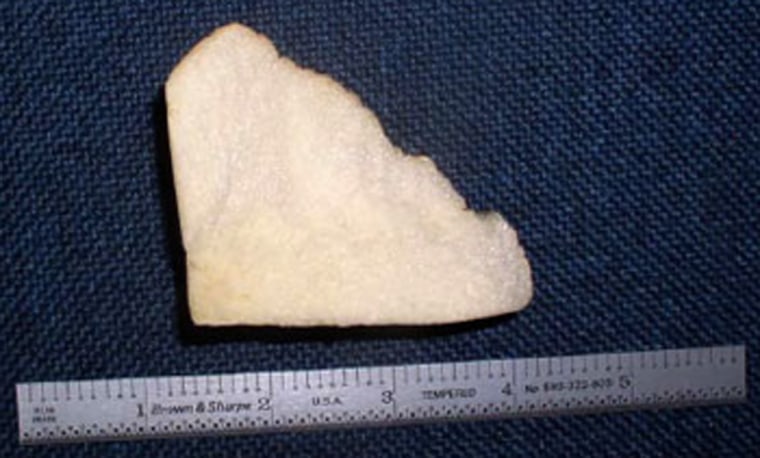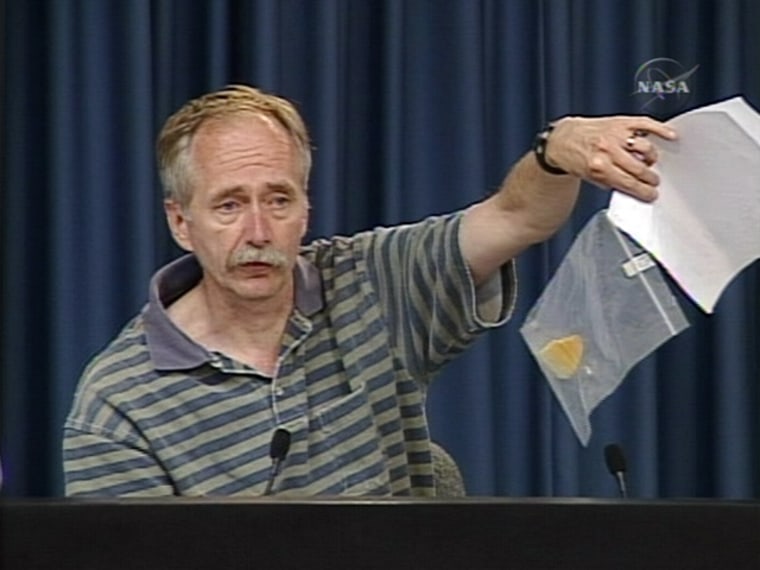CAPE CANAVERAL, Fla. - NASA managers gave the go-ahead Monday night for a Fourth of July space shuttle launch, even though a piece of foam insulation the size of a corner of bread crust fell off Discovery’s external fuel tank.
"We're go to continue with the launch countdown for STS-121," Bill Gerstenmaier, NASA's associate administrator for space operations, told reporters at Kennedy Space Center.
The decision sets the stage for an Independence Day launch at 2:38 p.m. ET. If the shuttle goes off on time, Discovery's flight would represent the first manned U.S. space mission to be launched on the Fourth of July.
The debate over the fuel-tank foam arose after Sunday's weather-related postponement of the launch, while pad workers were doing a post-scrub inspection of the shuttle orbiter and the tank. The inspectors spotted a crack in the foam on a liquid-oxygen feed-line bracket near the top of the fuel tank.
Later, they noticed that a piece was missing from the cracked area, and that piece was found on Discovery's launch platform, said John Shannon, chairman of NASA's mission management team.
The foam fragment measures about 3 inches (7.5 centimeters) wide and weighs only .0057 pounds (2.6 grams). That's roughly the weight of a penny, and less than half the weight of debris that would spark concern about damage to the shuttle orbiter (.013 pounds).
Managers weighed three other issues before clearing the tank for launch:
- Engineers believed the foam loss would not pose problems for the shuttle during ascent, but NASA wanted engineers to do further analysis of the aerodynamics. "They fully have shown that the foam is good and ready to go fly," Gerstenmaier said Monday night.
- NASA wanted to make sure the missing foam wouldn't lead to excessive ice buildup on the tank in the hours before launch. Gerstenmaier said projections indicated that even in a worst-case scenario, the amount of ice that could form in the area was well within specified limits. Nevertheless, inspectors would keep a close watch during the countdown, and if excessive ice were to form, the countdown would be halted, he said.
- Mission managers also wanted reassurances that there were no heightened risks of additional foam loss. Gerstenmaier said workers improvised a new inspection device, consisting of a boroscope camera mounted on the end of an 8-foot-long (2.4-meter-long) flexible plastic tube, which could peer around corners and document that the foam appeared safe. "The ground ops team came to the rescue with a great inspection technique that allowed us to get a really good close look at this," he said.
By Monday evening, NASA's management team agreed to go ahead with launch preparations. Gerstenmaier said there was "lots of discussion from many people during the review ... but essentially no dissenting opinions with where we're going." Among those in attendance was NASA Administrator Mike Griffin, he said.
Some outside observers have wondered whether NASA was moving too resolutely toward launch, a phenomenon known as "go fever." Mission managers already have modified their flight rules once by determining that Discovery's crew could work around a bad heater for a maneuvering thruster rather than waiting for a fix.
However, Gerstenmaier said the space agency was setting objective criteria for liftoff, and consistently following those criteria. "I don't think we're taking any additional risk than we did in our original assessment," he said.
Discovery's launch is still dependent on the weather. The current launch window extends until July 19, and if NASA can't send Discovery on its test mission to the international space station this month, the next window for liftoff would open Aug. 28.
Forecasters set the chances of having favorable weather for launch at 60 percent for Tuesday, and 40 percent if the countdown had to be delayed until Wednesday. Mission managers skipped Monday's launch opportunity to prepare for Tuesday and Wednesday instead, but the unofficial word was that the weather might well have been "go" for launch on Monday.
Heightened concerns about foam
Concern about foam debris has been heightened in the wake of the 2003 Columbia tragedy, which investigators say occurred because a 1.6-pound (730-gram) piece of flying foam damaged the leading edge of the shuttle Columbia's wing shortly after launch. Later, during Columbia's descent, superheated gases entered the breach and destroyed the shuttle from within, killing all seven astronauts.

The top objective of this month's mission is to test the enhancements of the past year — and some engineers have said NASA should have waited until even further enhancements were done. Thus, any loss of foam, however slight, raises concern.
"I think it would not have gotten as much attention prior to Columbia as it has gotten now," Shannon observed.
Did rain play a role?
The launch already has been rescheduled twice, on Saturday and Sunday, both times because threatening clouds came too close to Kennedy Space Center.
On Sunday, rain showers swept over Discovery at the pad, and Shannon said rainwater most likely entered a small crevice in the feed-line bracket foam. That trapped water could have frozen and expanded during contact with the chilled tank, then thawed as the tank was drained — opening the crack further.
The cracked material was likely flexed when the launch pad's rotating service structure was moved back toward the orbiter, leading to the break-off of the small foam piece, Shannon said.
While mission managers weighed their decision on the countdown, the launch-pad team finished its timeline for replenishing liquid-hydrogen supplies on the shuttle in preparation for a Tuesday launch.
Discovery's 12-day mission is aimed at testing the safety improvements made to the shuttle as well as resupplying the space station, replacing equipment on the station and dropping off a third station crew member.
With Monday's replenishment, NASA is hoping that Discovery will have enough power-generating fuel to allow an extension of Discovery's mission to a 13th day — which would make time for an extra spacewalk to test techniques for repairing an injured shuttle.
